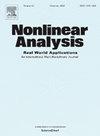Enhanced dissipation and temporal decay in the Euler–Poisson–Navier–Stokes equations
IF 1.8
3区 数学
Q1 MATHEMATICS, APPLIED
引用次数: 0
Abstract
This paper investigates the global well-posedness and large-time behavior of solutions for a coupled fluid model in consisting of the isothermal compressible Euler–Poisson system and incompressible Navier–Stokes equations coupled through the drag force. Notably, we exploit the dissipation effects inherent in the Poisson equation to achieve a faster decay of fluid density compared to velocities. This strategic utilization of dissipation, together with the influence of the electric field and the damping structure induced by the drag force, leads to a remarkable decay behavior: the fluid density converges to equilibrium at a rate of , significantly faster than the decay rates of velocity differences and velocities themselves in the norm. Furthermore, under the condition of vanishing coupled incompressible flow, we demonstrate an exponential decay to a constant state for the solution of the corresponding system, the damped Euler–Poisson system.
欧拉-泊松-纳维-斯托克斯方程的增强耗散和时间衰减
本文研究了等温可压缩欧拉-泊松系统和不可压缩Navier-Stokes方程在阻力作用下的耦合流体模型的全局适定性和大时性。值得注意的是,我们利用泊松方程中固有的耗散效应来实现流体密度比速度更快的衰减。这种对耗散的策略利用,加上电场和阻力诱导的阻尼结构的影响,导致了显著的衰减行为:流体密度以(1+t)−11/4的速率收敛到平衡状态,明显快于L2范数中速度差(1+t)−7/4和速度本身(1+t)−3/4的衰减速率。此外,在耦合不可压缩流消失的条件下,我们证明了相应的系统,即阻尼欧拉-泊松系统的解的指数衰减到恒定状态。
本文章由计算机程序翻译,如有差异,请以英文原文为准。
求助全文
约1分钟内获得全文
求助全文
来源期刊
CiteScore
3.80
自引率
5.00%
发文量
176
审稿时长
59 days
期刊介绍:
Nonlinear Analysis: Real World Applications welcomes all research articles of the highest quality with special emphasis on applying techniques of nonlinear analysis to model and to treat nonlinear phenomena with which nature confronts us. Coverage of applications includes any branch of science and technology such as solid and fluid mechanics, material science, mathematical biology and chemistry, control theory, and inverse problems.
The aim of Nonlinear Analysis: Real World Applications is to publish articles which are predominantly devoted to employing methods and techniques from analysis, including partial differential equations, functional analysis, dynamical systems and evolution equations, calculus of variations, and bifurcations theory.

 求助内容:
求助内容: 应助结果提醒方式:
应助结果提醒方式:


